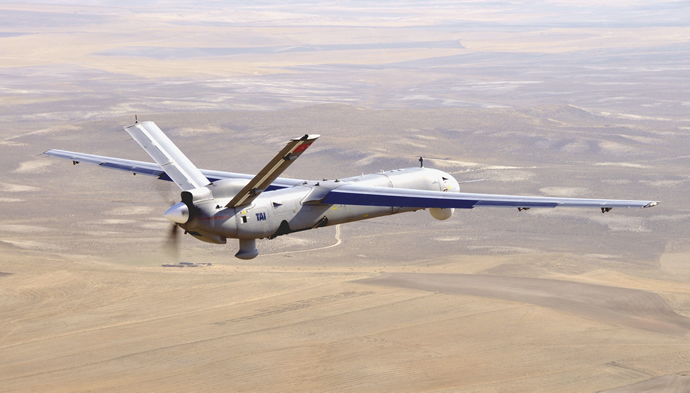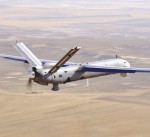

Unmanned Aerial Systems (UAS) have proven their worth by successful, continued operations in the War Against Terror for more than a decade, raising the bar, after the elimination of arch-terrorist Osama Ben Laden by United States Forces in Pakistan.
As more countries seek to induct UASs with their defense forces, some of those who wish to develop their technological and industrial capabilities deliver Intelligence, Surveillance and Target Acquisition and Reconnaissance (ISR/ISTAR) platforms, establishing local manufacturing of UASs. The UAE is one of the most prominent of these countries. At the Dubai International Air Chiefs’ Conference on 12 November, Deputy Air Force Chief, Maj Gen Ibrahim Naser al-Alawi, announced that the United Arab Emirates (UAE) would be acquiring an unarmed unmanned air system for intelligence gathering and that the UAE soon intends to expand its surveillance technology and capabilities by using UASs. He continued that the UAE will be operating an air operations centre in 2013 and will establish a terminal high-altitude area defense missile system shortly afterwards.
The two companies who intend to compete on the ensuing UAE’s UAS programme are UAE based, International Golden Group (IGG) and Turkish based, Turkish Aerospace Industries (TAI). International Golden Group distributes security and marine defense products and systems, which includes systems engineering, sensors, robotics and observation solutions. IGG is a well-known private joint stock company based in Abu Dhabi, UAE.

On February 24, 2011, the 5th day of IDEX defense show, IGG announced that twenty-six percent (26%) of the total shareholdings of IGG had been purchased by Tawazun Holdings, the investment arm of the UAE Bureau of Offsets Program under a year 2010 agreement. The CEO of the Offsets Bureau and Tawazun Holdings is H.E. Saif Mohamed al Hajeri. Tawazun operates within the scope of various commercial mandates that contribute to the industrialization of the UAE. Consequently, Mr. Fadil Al Kaabi, the CEO of IGG recently said that his company would be advancing to manufacturing capabilities of certain products.
On February 23, 2011, General Atomics Aeronautical Systems, Inc. (GA-ASI) announced that it had signed an MOU with the International Golden Group (IGG) to sell a new version of its premier UAS, the Predator known as the the XP model to the UAE government. The GA-ISA Predator XP is set for production for the Predator XP in 18 months. Although the Predator has been in service as an unarmed platform during the Balkan war since 1995, its weaponization in 2001 was significant. The RQ-1 Predator drone (later designated MQ-1 for its weapon carrying role) became the primary UAS used for offensive combat operations by the US Air Force and the CIA in Afghanistan and Pakistan for use against insurgents, logging over a million flight hours. Despite its high profile, however, the Predator was not widely exportable due to U.S. export regulations. On March 3, 2011, the GA-ASI ceased production of the Predator A (RQ-1) since nowadays GA-ASI produces only the larger MQ-9 Reaper (Predator B) and other UASs for the US Air Force and few NATO customers.
While the Predator XP is still being developed, it has been reported that it will offer comparable Intelligence, Surveillance and Reconnaissance (ISR) capabilities as the RQ-1 version. It is assumed that the Predator XP exhibits the same physical dimensions. The Predator XP may be integrated with multiple exportable sensors, including Electro-Optical Infrared (EO/IR) multi-sensor payload and the Lynx Multi Mode Synthetic Aperture Radar (SAR) also produced by GA-ASI.
[box type=”info” style=”rounded” border=”full”]
MTCR Guidelines Regarding Category II Weapons section 5 (a) and (b)
“Where the transfer could contribute to a delivery system for weapons of mass destruction, the Government will authorize transfers of items in the Annex only on receipt of appropriate assurances from the government of the recipient state that:
- The items will be used only for the purpose stated and that such use will not be modified nor the items modified or replicated without the prior consent of the Government;
- Neither the items nor replicas nor derivatives thereof will be re-transferred without the consent of the Government.”
[/box]
This specific model of the Predator, the XP, has recently been licensed by the U.S. Government for export, under the Missile Technology Control Regime (MTCR) Category II in order to be proposed for sale to a broader customer base worldwide, especially countries in the Middle East and North Africa. The Predator combat design has been modified to remove the hard points used by the USAF to carry weapons such as air-to-surface missiles and restricted to maintain a gross takeoff weight below 500kg (1,100lb),operating at a distance of 160nm (300km). Production is set to begin by the year 2013.
“We’re trying to market that version to the UAE, Saudi Arabia and a few other countries” Mr Frank Pace, CEO of GA-ASI, noted. “GA-ASI’s establishment of a working relationship with IGG represents a strategic commitment by both companies to help the UAE strengthen its national security and protect critical infrastructure”, said J. Neal Blue, chairman of GA. While the details of the MOU have not been disclosed, perhaps under the new export classification, know-how for the manufacture and production of the Predator XP could be transferred, at least in part, from GA-ASI (USA) to IGG (UAE) as part of an offset arrangement. GA-ASI is not the only company eyeing this lucrative market. TAI of Turkey is promoting the Anka UAS to fulfill the UAE requirement. While Anka is currently undergoing flight testing, this MALE drone is also expected to be available and operational by the year 2013.
Unlike the Category II Predator XP, the baseline performance of Anka is designed as a heavier platform (1.6 ton maximum takeoff weight) carrying 200 kg (440 lb) of useful payload on 24 hour missions. The Turkish Air Force is expected to be the lead customer for the drone, fielding the Anka in 2012. The question remains if the new UASs will be game changers, which will push the leading UAS manufacturers to offer innovative design solutions to meet new operational objectives within these MTCR guidelines.
About the author: Lori Solberg (MBA, Adv.)
Former deputy general counsel of Rafael Advanced Defense Systems (international), Lori Solberg provides customized general and business advice to advanced technology and defense companies. She specializes in business market expansion in the defense and HLS fields worldwide as well as representation before international export control authorities.
















